The allure of scoring a deal on secondhand equipment can be tempting, especially with the current surge in sustainable shopping practices. However, the excitement of a bargain often brings along a suitcase of concerns, particularly for upholstered items. So, should hygiene be a deal-breaker? Let’s untangle the complexities of acquiring used upholstered equipment, ensuring both your wallet and well-being are in good shape.
1. Hidden Tenants: The Microbial Landscape:
Upholstered items, thanks to their fibrous nature, can be a haven for microbes. From bacteria and fungi to tiny mites, these items can house a plethora of organisms, some of which might be potential allergens or pathogens.
2. The Scourge of Stains and Spills:
Unlike hard surfaces, upholstered items can retain spills and stains, some of which might be organic, serving as nutrient sources for microbial growth.
3. Atmospheric Invaders: Mold and Mildew:
Stored in damp conditions, secondhand upholstered equipment can be a breeding ground for mold and mildew. Besides being potential health hazards, they can also exude an unpleasant odor.
4. The Pervasive Dust Mites:
These microscopic critters are commonly found in upholstery and can trigger allergic reactions in sensitive individuals. A used piece of equipment might carry a higher mite load than you’d anticipate.
5. From Pet to Pest: Fleas and Ticks:
If the previous owner had pets, there’s a chance that fleas or ticks might have made the equipment their home.
6. Modern Cleaning Solutions:
Fortunately, innovation in cleaning technology offers solutions:
- Steam Cleaning: High-temperature steam can effectively kill most microbes and pests, making it a top choice for sanitizing upholstered equipment.
- UV-C Light Treatments: Ultraviolet light, especially UV-C spectrum, can be lethal for bacteria and viruses. Portable UV-C lamps can be used to disinfect upholstered surfaces.
- Eco-friendly Upholstery Shampoos: For those concerned about chemical residues, several eco-friendly shampoos can cleanse without leaving potentially harmful traces.
7. DIY Deep Cleanse:
If professional cleaning services are out of reach, a thorough vacuuming followed by spot cleaning using a mixture of white vinegar, water, and mild detergent can be surprisingly effective. Ensure you air out the equipment post-cleaning to prevent moisture retention.
8. Protective Overhauls:
Consider investing in protective covers. Not only can these prevent future contamination, but they can also offer a fresh look to used equipment.
9. Knowledge is Power:
When purchasing secondhand upholstered equipment, don’t hesitate to question the seller. Understanding the storage conditions, the presence of pets, and any significant spills can guide your cleaning approach.
10. The Trust in Certification:
A few organizations offer certifications for sanitized secondhand items. If you’re purchasing from a store, look for these certifications as a badge of hygiene assurance.
Conclusion:
While hygiene concerns with used upholstered equipment are genuine, they aren’t insurmountable. With a mix of modern cleaning techniques and old-fashioned vigilance, you can enjoy the benefits of secondhand shopping without compromising on cleanliness. After all, with sustainability as the need of the hour, making secondhand items safe for reuse is a step towards a greener and cleaner future.

